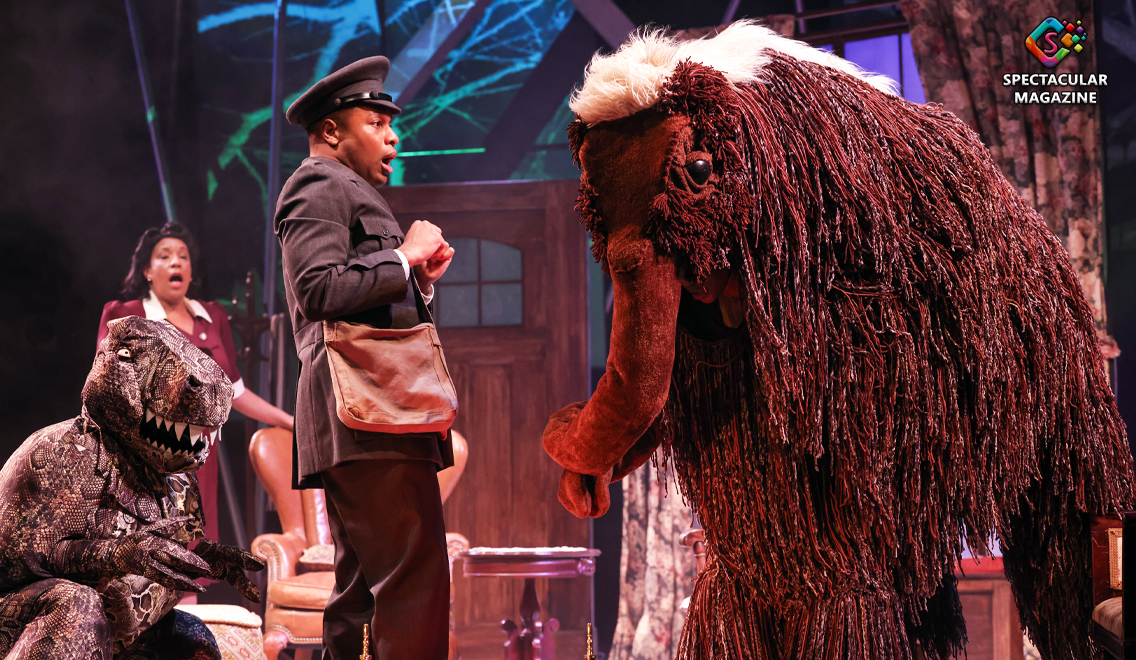(Review) Playmakers’ Multi-Racial, Multi-Generational “The Skin of Our Teeth” Does Not Disappoint!
CHAPEL HILL – Thornton Wilder’s The Skin of Our Teeth is taking the Triangle theater scene by storm. The show’s home now until Nov. 28 is the Joan H. Gillings Center for Dramatic Art on the campus of UNC-Chapel Hill.
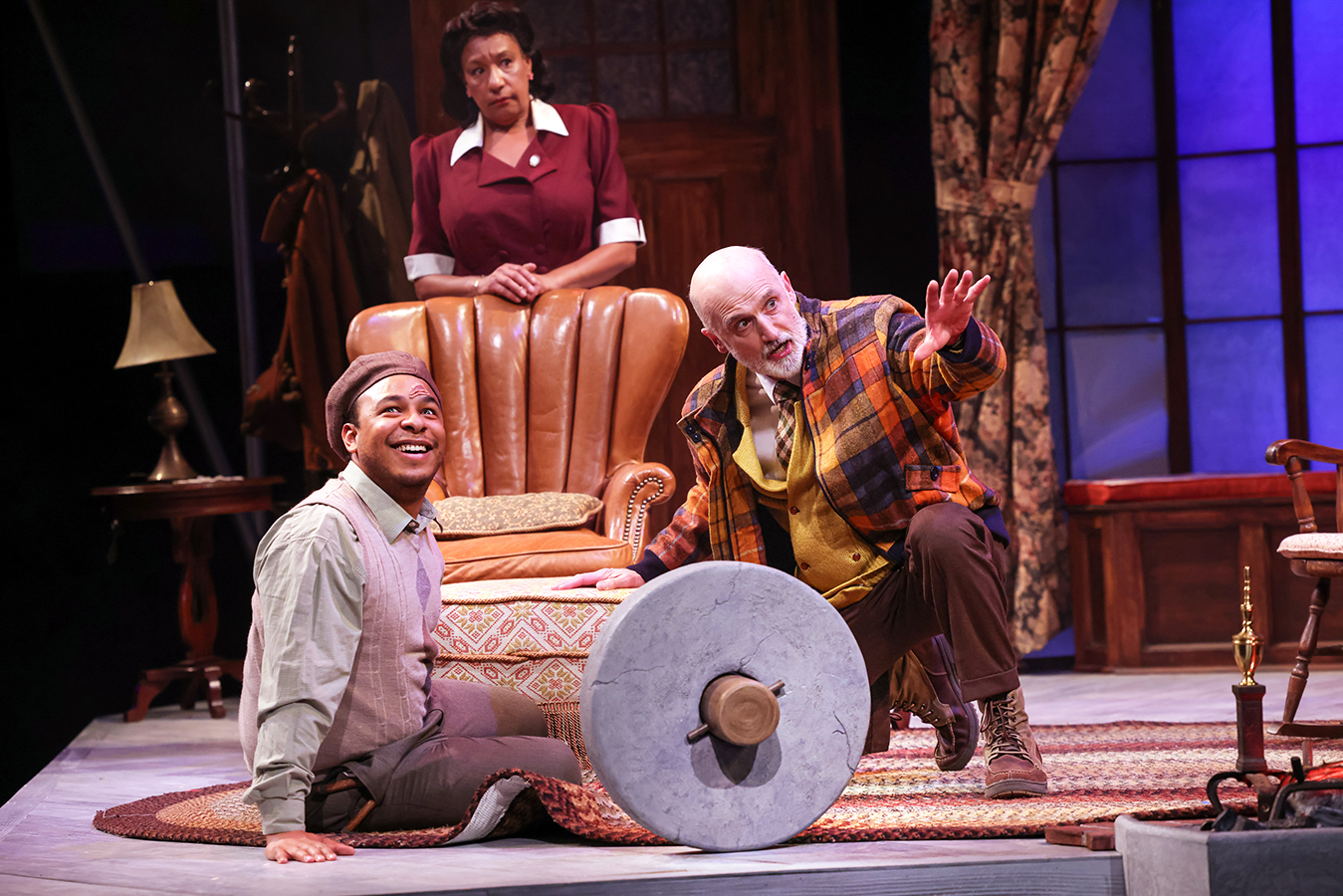
The PlayMakers Repertory Company production stars Kathryn Hunter-Williams (as matriarch Mrs. Antrobus) and Ray Dooley (as patriarch Mr. Antrobus). Broadway alumna Vivienne Benesch directs. Benesch will also helm Broadway’s upcoming Birthday Candles, starring Debra Messing.
The entire plot takes place in a far-flung, exotic locale – New Jersey. Skin is a play in three acts. The overall runtime is roughly two-and-a-half hours – an already-long play made even longer by a pre-show directorial filibuster. Not even an audience supermajority could stop her. Oh, I kid. Benesch is an accomplished artist passionate about her craft. She earned her moment on the soapbox. And having to listen to a woman’s earnest soliloquy is not the end of the world – right?
Speaking of the end of the world…Skin’s apocalyptic theme is perhaps more topical than ever (what with our planet being on fire, and all). Act I even features climate refugees, and a domestic debate regarding their admission into the country – er, house. I dare any viewer of Skin to not recall the COVID-19 pandemic and the climate crisis. Especially in Act II, when blissfully ignorant citizens pretend that they are not in imminent danger. PlayMakers were almost certainly aware of Skin’s enduring offstage applicability. The character of Sabina says it herself: “I advise you not to think about the play.”
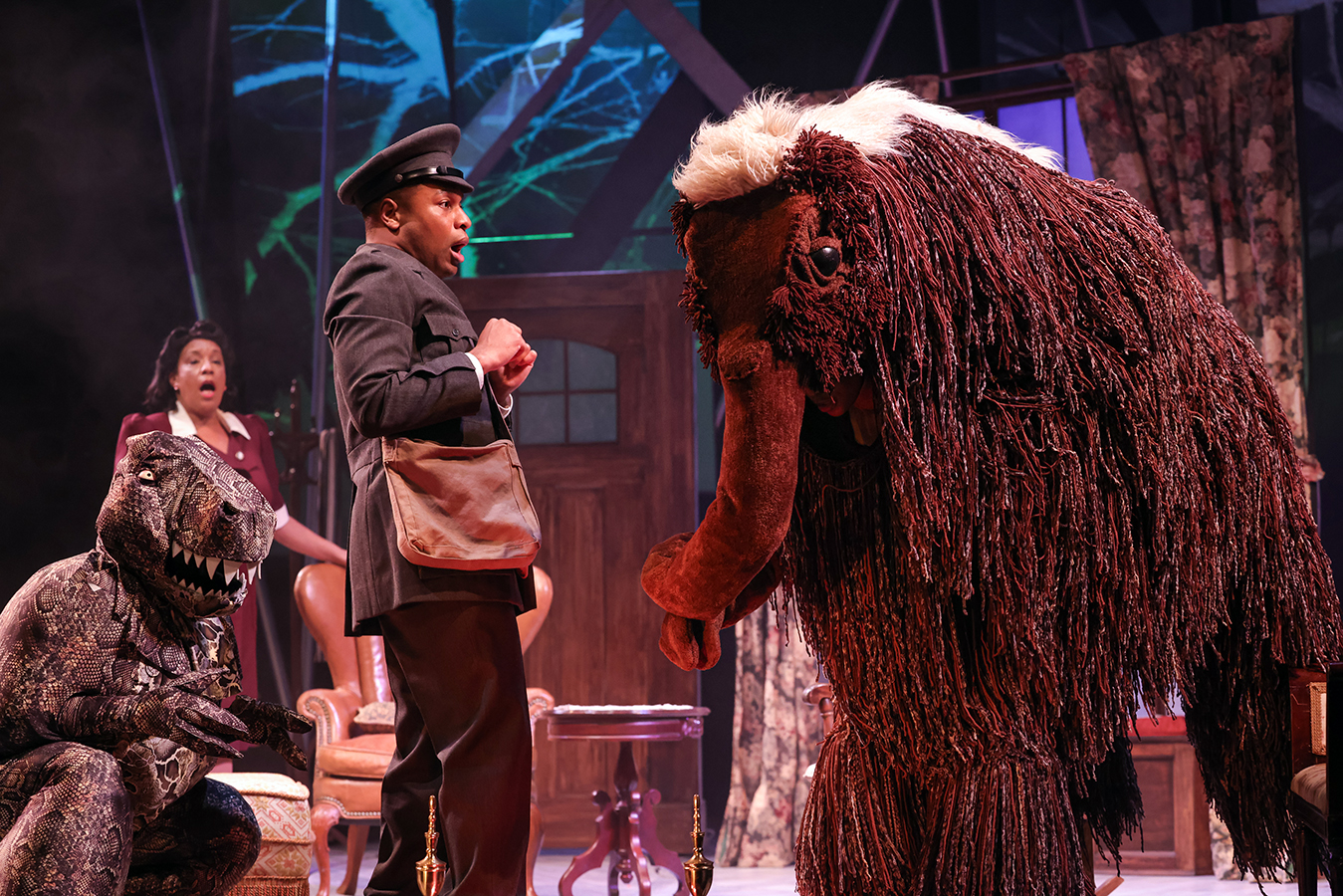
In keeping with Greco-Roman literary tradition, The Skin of Our Teeth begins in medias res – in the middle of things. Hark! A new ice age is upon us! Sheltering in place in their suburban abode is the all-American, quasi-Paleolithic Antrobus family: mother Maggie, father George, daughter Gladys, and son Henry. A petlike mammoth and T-rex accompany them.
Skin is far from the only work to parody bourgeois America by means of primitivization. Some other notable examples include “Body Ritual Among the Nacirema” (1956) and The Flintstones (1960-66). Heck, you could even throw DreamWorks’ The Croods in there. The Skin of Our Teeth is a ham-fisted commentary on the American family, Western civilization, and humankind at large. Indeed, there’s a shroud of cynicism about the work, but there are moments wherein Wilder’s affection for his species shines through. It goes without saying – there are some tone inconsistencies here. None of this is the doing of PlayMakers. They executed a solid, technically-savvy operation.
The production is jammed with gimmicks galore. A talking mammoth! A garish 80s song and dance number! Cameos by the Honorable Judge Moses (yes, that Moses) and a strung-out Homer! And for the menfolk, a leggy redhead in fishnets…hubba hubba. Just don’t let the missus catch your jaw hanging, fellas.
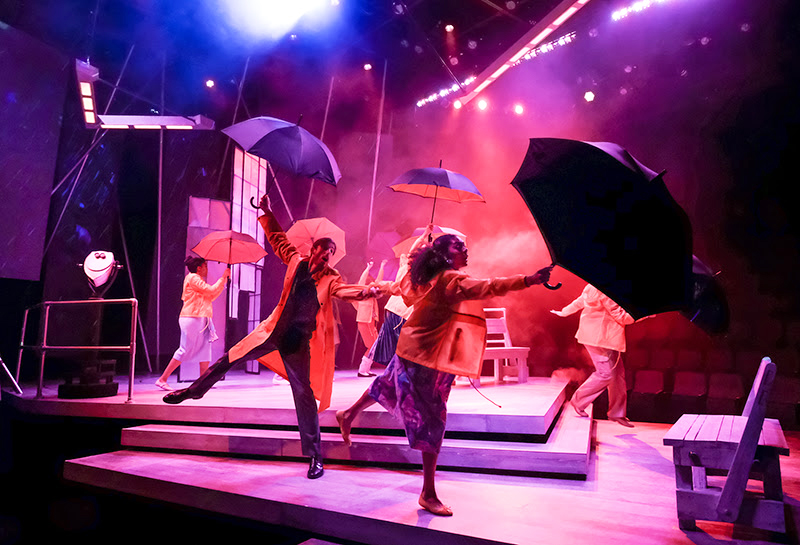
The 80s-themed second act is sure to delight anyone over the age of 40…again, kidding. Tracy Bersley’s choreography was an unexpected treat. Act II was a rollicking (at times lurid) forty-five minutes. Since basically everything in this play is an allegory, allusion, or metaphor, is Act II a conscious critique of the acid-washed, shoulder-padded hedonism of the Reagan years? An artistic rebuke of conspicuous consumption and yuppie-ism? Probably not. But still…fun!
Oh, and fine costumery throughout by McKay Coble – but particularly in Acts I and II.
Esoteric theological and philosophical references abound in Skin. These may be more even inaccessible to today’s audiences than 1942’s. Nonetheless, PlayMakers make the best of the ambitious yet convoluted source material.
Wayward son Henry rebels against the Enlightenment and his father’s compendia of classical works. Philosophers Max Horkheimer and Theodor Adorno chronicled the decay of Western enlightenment from Ancient Greece (which figures prominently in Skin) to the advent of fascism (alluded to in Skin) millennia later. Many scholars have characterized fascism as a backlash against liberalism and the Age of Enlightenment. Today, recent years have seen a similar trend. Mr. Antrobus and his reading habits embody Enlightenment values, and Henry resents it deeply. The Skin of Our Teeth premiered at the height of World War II, and war dominates Act III.
This play has a lot of yelling and – as I could observe from back in Row F – a lot of respiratory droplets. A fine mist, really. Thankfully, the director assured the audience the PlayMakers’ team has taken the appropriate COVID precautions.
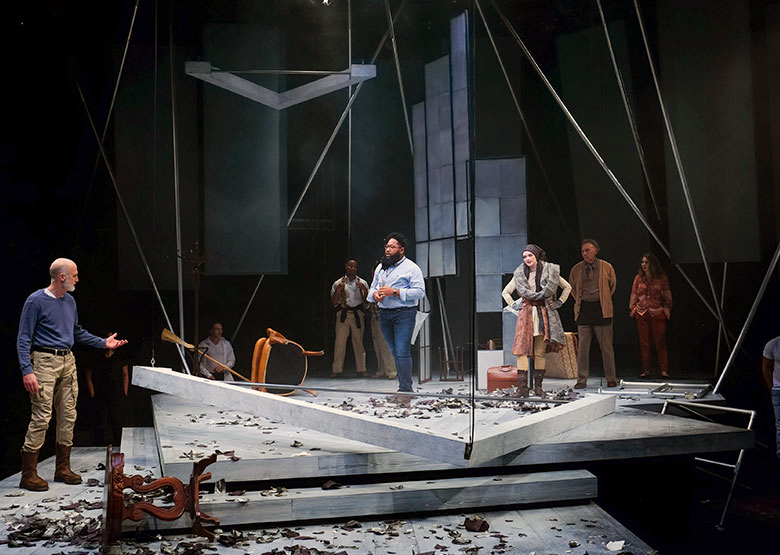
PlayMakers showcases a multiracial cast: Sabina is white, Mr. Antrobus is white, and the rest of the Antrobus family is Black. This is good and all, but there may be an unforeseen consequence here. It is mildly uncomfortable to watch white characters explicitly and implicitly insult the physical appearance of Mrs. Antrobus, a Black woman. This happens throughout the course of the play. Perhaps it would behoove theatergoers to suspend their disbelief and imagine a colorblind world without racist beauty standards. Additionally, the household repeatedly defers to Mr. Antrobus as their “master.” Mr. Antrobus supposedly whips his son as well. Albeit, this is true to Wilder’s original script…but PlayMakers still modernized a few lines here and there. Why not these ones?
Sometimes, there’s a fine line between color-blind and tone-deaf.
The male gaze is a recurrent motif in Skin. Mr. Antrobus, who runs for high office, oversees a beauty contest. A New York area businessman, politician, and pageant judge… sound familiar?
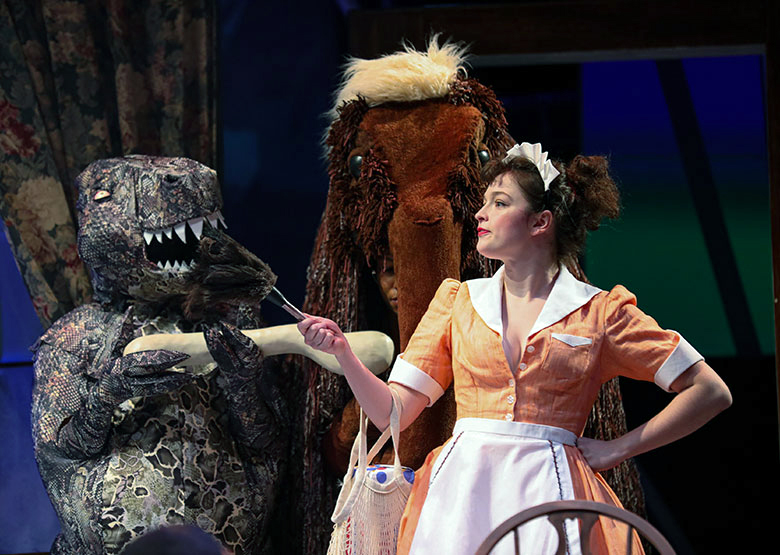
The production is well-acted. Tori Jowell dominates the show as seductress Sabina. The Skin of Our Teeth is a study in anthropology, and Jewell has a B.A. in anthropology. Coincidence? Most likely.
The drama reaches a crescendo in Act III, with a showstopping performance by Anthony August (Henry). Kathryn Hunter-Williams is exquisite as Mrs. Antrobus. Omolade Wey hams it up as Gladys Antrobus. I found performances by minor characters to be quite remarkable, such as those by Heinley Gaspard (Fitz), Sergio Mauritz Ang (Esmeralda), Saleemah Sharpe (Ivy), Sanjana Taskar (Miss M. Muse), and Adam Valentine (Doctor). As famed theatre practitioner Konstantin Stanislavski once said, “There are no small parts. Only small actors.”
There were a few technical and staging issues. The sound was inconsistent (Mr. Antrobus was the hardest to hear) and there was some clumsy blocking. The play is best suited, in my opinion, for a larger, proscenium-type platform. The PlayMakers’ thrust stage became overpopulated at times. Suspended from the ceiling were awkward triangular beams that were lowered to the floor in Act III. What was at first an ungainly, unnecessary configuration was now a definite tripping hazard – now with an open trapdoor right beside it! Oh, well. I’ll let the actor’s union figure that one out.
In conclusion, though the source material is something of a hot mess, the multi-racial, multi-generational PlayMakers’ production does not disappoint! The Skin of Our Teeth’s message was relevant in 1942 and is just as relevant in 2021.
The Skin of Our Teeth is playing at the Paul Green Theatre until Nov. 28. Tickets (click here) start at $20. Please be mindful of COVID-related precautions. Be forewarned that the production will use fog, haze, smoke, and strobe effects. There are minor instances of violence and profanity.


